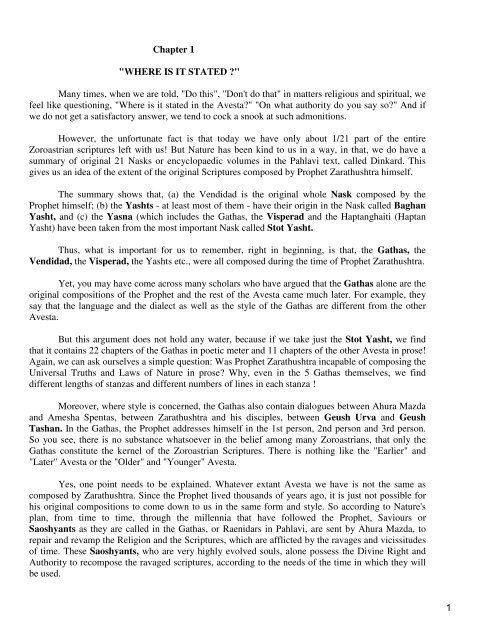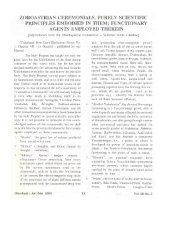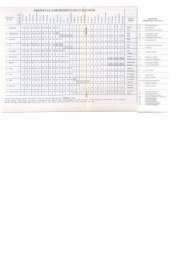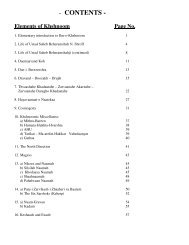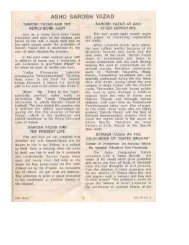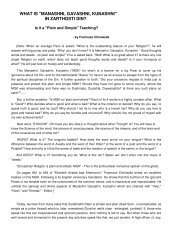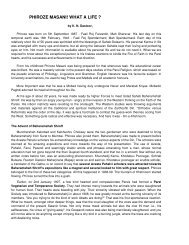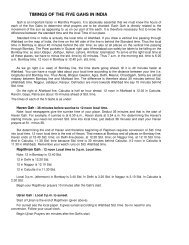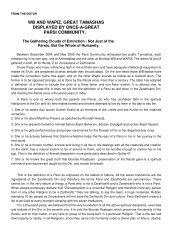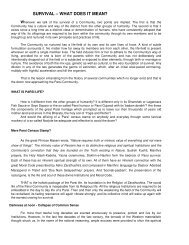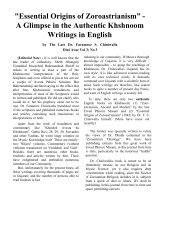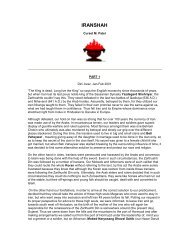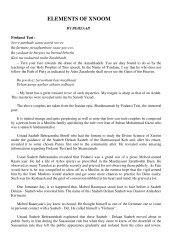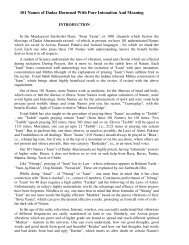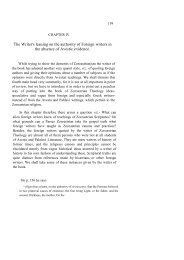Acceptance – Never Ever. - Traditional Zoroastrianism: Tenets of the ...
Acceptance – Never Ever. - Traditional Zoroastrianism: Tenets of the ...
Acceptance – Never Ever. - Traditional Zoroastrianism: Tenets of the ...
You also want an ePaper? Increase the reach of your titles
YUMPU automatically turns print PDFs into web optimized ePapers that Google loves.
Chapter 1<br />
"WHERE IS IT STATED ?"<br />
Many times, when we are told, "Do this", "Don't do that" in matters religious and spiritual, we<br />
feel like questioning, "Where is it stated in <strong>the</strong> Avesta?" "On what authority do you say so?" And if<br />
we do not get a satisfactory answer, we tend to cock a snook at such admonitions.<br />
However, <strong>the</strong> unfortunate fact is that today we have only about 1/21 part <strong>of</strong> <strong>the</strong> entire<br />
Zoroastrian scriptures left with us! But Nature has been kind to us in a way, in that, we do have a<br />
summary <strong>of</strong> original 21 Nasks or encyclopaedic volumes in <strong>the</strong> Pahlavi text, called Dinkard. This<br />
gives us an idea <strong>of</strong> <strong>the</strong> extent <strong>of</strong> <strong>the</strong> original Scriptures composed by Prophet Zarathushtra himself.<br />
The summary shows that, (a) <strong>the</strong> Vendidad is <strong>the</strong> original whole Nask composed by <strong>the</strong><br />
Prophet himself; (b) <strong>the</strong> Yashts - at least most <strong>of</strong> <strong>the</strong>m - have <strong>the</strong>ir origin in <strong>the</strong> Nask called Baghan<br />
Yasht, and (c) <strong>the</strong> Yasna (which includes <strong>the</strong> Gathas, <strong>the</strong> Visperad and <strong>the</strong> Haptanghaiti (Haptan<br />
Yasht) have been taken from <strong>the</strong> most important Nask called Stot Yasht.<br />
Thus, what is important for us to remember, right in beginning, is that, <strong>the</strong> Gathas, <strong>the</strong><br />
Vendidad, <strong>the</strong> Visperad, <strong>the</strong> Yashts etc., were all composed during <strong>the</strong> time <strong>of</strong> Prophet Zarathushtra.<br />
Yet, you may have come across many scholars who have argued that <strong>the</strong> Gathas alone are <strong>the</strong><br />
original compositions <strong>of</strong> <strong>the</strong> Prophet and <strong>the</strong> rest <strong>of</strong> <strong>the</strong> Avesta came much later. For example, <strong>the</strong>y<br />
say that <strong>the</strong> language and <strong>the</strong> dialect as well as <strong>the</strong> style <strong>of</strong> <strong>the</strong> Gathas are different from <strong>the</strong> o<strong>the</strong>r<br />
Avesta.<br />
But this argument does not hold any water, because if we take just <strong>the</strong> Stot Yasht, we find<br />
that it contains 22 chapters <strong>of</strong> <strong>the</strong> Gathas in poetic meter and 11 chapters <strong>of</strong> <strong>the</strong> o<strong>the</strong>r Avesta in prose!<br />
Again, we can ask ourselves a simple question: Was Prophet Zarathushtra incapable <strong>of</strong> composing <strong>the</strong><br />
Universal Truths and Laws <strong>of</strong> Nature in prose? Why, even in <strong>the</strong> 5 Gathas <strong>the</strong>mselves, we find<br />
different lengths <strong>of</strong> stanzas and different numbers <strong>of</strong> lines in each stanza !<br />
Moreover, where style is concerned, <strong>the</strong> Gathas also contain dialogues between Ahura Mazda<br />
and Amesha Spentas, between Zarathushtra and his disciples, between Geush Urva and Geush<br />
Tashan. In <strong>the</strong> Gathas, <strong>the</strong> Prophet addresses himself in <strong>the</strong> 1st person, 2nd person and 3rd person.<br />
So you see, <strong>the</strong>re is no substance whatsoever in <strong>the</strong> belief among many Zoroastrians, that only <strong>the</strong><br />
Gathas constitute <strong>the</strong> kernel <strong>of</strong> <strong>the</strong> Zoroastrian Scriptures. There is nothing like <strong>the</strong> "Earlier" and<br />
"Later" Avesta or <strong>the</strong> "Older" and "Younger" Avesta.<br />
Yes, one point needs to be explained. Whatever extant Avesta we have is not <strong>the</strong> same as<br />
composed by Zarathushtra. Since <strong>the</strong> Prophet lived thousands <strong>of</strong> years ago, it is just not possible for<br />
his original compositions to come down to us in <strong>the</strong> same form and style. So according to Nature's<br />
plan, from time to time, through <strong>the</strong> millennia that have followed <strong>the</strong> Prophet, Saviours or<br />
Saoshyants as <strong>the</strong>y are called in <strong>the</strong> Gathas, or Raenidars in Pahlavi, are sent by Ahura Mazda, to<br />
repair and revamp <strong>the</strong> Religion and <strong>the</strong> Scriptures, which are afflicted by <strong>the</strong> ravages and vicissitudes<br />
<strong>of</strong> time. These Saoshyants, who are very highly evolved souls, alone possess <strong>the</strong> Divine Right and<br />
Authority to recompose <strong>the</strong> ravaged scriptures, according to <strong>the</strong> needs <strong>of</strong> <strong>the</strong> time in which <strong>the</strong>y will<br />
be used.<br />
1


